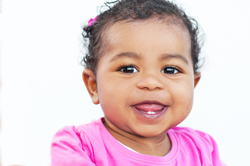Teething

Your otherwise calm baby has turned into a drooling, cranky, red-cheeked little crier. You watch as he is constantly biting, chewing and rubbing his gums with anything he can get his hands on. His own hands and fingers have taken up permanent residence in his mouth, and it seems that he can’t find relief.
Break out the bubbly, your little toothless wonder has hit a major milestone — Teething.
Teething is when your baby’s “baby” or “milk” teeth come in, a process that really doesn’t feel good for most babies. This usually happens anytime between six and nine months, but if your baby is slightly younger or older, don’t worry, every baby is different.
You may be fortunate enough where your baby doesn’t exhibit any symptoms or discomfort and you wake up to a little cutie with one or two new teeth. But if you’re like most of us, your baby will likely suffer some discomfort and pain.
Common Symptoms:
• An elevated temperature (not a fever)
• Swollen gums
• Drooling
• Irritability/fussiness
• Crying
• Sleeplessness
• Refusal to eat or drink
• Pulling on their ears
• Mild rash around the mouth – caused by excessive drooling
• Cough – caused by excessive saliva dripping into their throat
What to do:
• Try to keep your baby as comfortable as possible through this. Extra hugs and more attention go a long way.
• A cold metal spoon can feel great on the gums (just make sure they don’t put the handle in their mouth and down their throat).
• A safe teething toy like a rubber, bumpy teething ring.
• Rub your own clean finger on/across your baby’s gums
• Place a wet washcloth in the freezer and once frozen offer it to your baby for relief.
• Use a baby toothbrush to brush his gums.
• Offer your baby cold foods such as: yogurt, applesauce, pureed fruit or a frozen banana.
• If your baby is over six months old you can give him some acetaminophen or ibuprofen to help relieve pain.
• Ask a naturopath about homeopathic remedies.
• If a rash or redness is present on your baby’s cheeks, wipe them with water and a washcloth, especially before and after sleep.
Some parents will swear up and down that their baby has a fever, diarrhea and terrible diaper rash when they are teething. Some will suggest that their baby’s drooling and excessive saliva is the cause of diarrhea, which in turn leads to a diaper rash. Most experts don’t agree. If your baby does get a diaper rash change his diaper more frequently, keep the area clean and apply a diaper rash cream to protect your baby’s skin.
Each baby is different and like adults they all have different tolerance levels for pain. While it’s normal for your baby to experience pain and discomfort, he really shouldn’t be in excruciating pain. If your baby has persistent diarrhea, is inconsolable, running a high fever and seems to be in a lot of pain take him to see his doctor, he could have an underlying condition or infection.
Congratulations for reaching this milestone! You’ll be happy to know that all symptoms will disappear once the tooth comes in.



